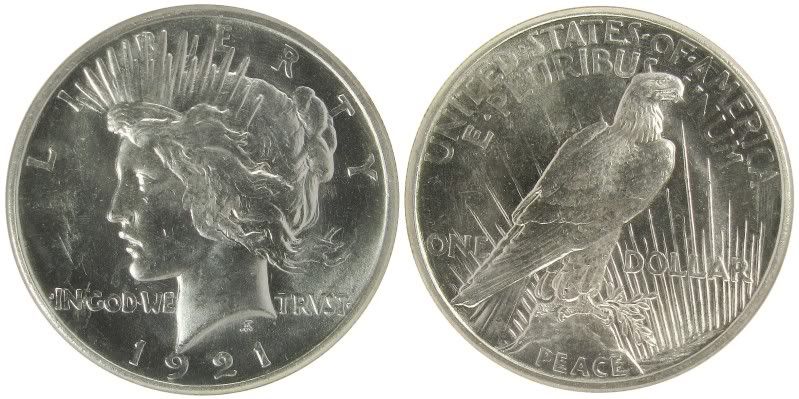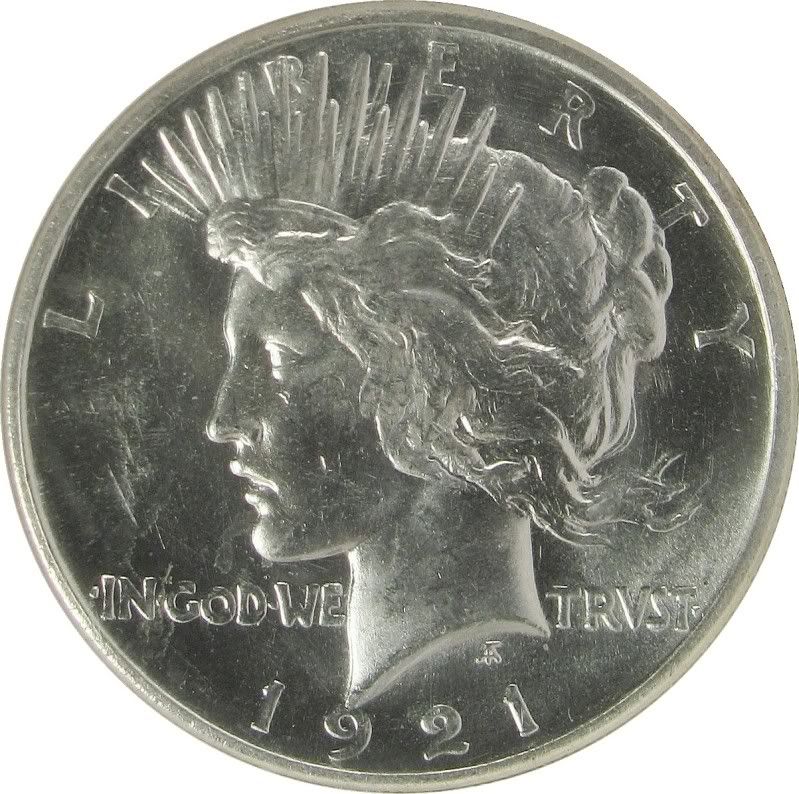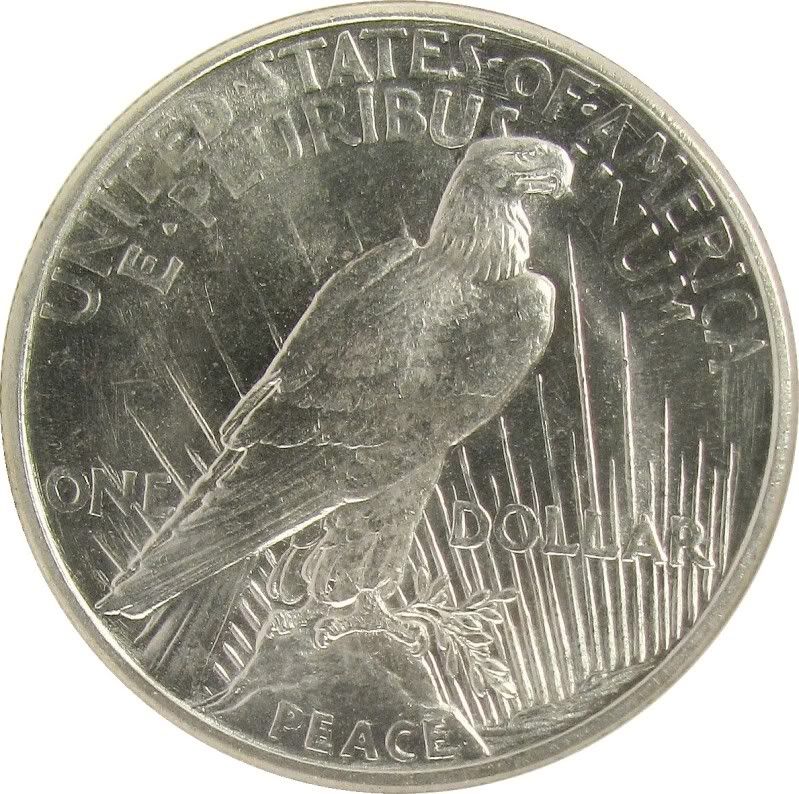1921 Peace Dollar (VAM-1H) - Struck from Satin Proof Dies
 Stuart
Posts: 9,831 ✭✭✭✭✭
Stuart
Posts: 9,831 ✭✭✭✭✭
Does anyone have any interesting comments or observations about this 1921 Peace Dollar?
1921 Peace Dollar



1921 Peace Dollar



Stuart
Collect 18th & 19th Century US Type Coins, Silver Dollars, $20 Gold Double Eagles and World Crowns & Talers with High Eye Appeal
"Luck is what happens when Preparation meets Opportunity"
0
Comments
The name is LEE!
of a great deal of the 1921's.
While examining the coin, I noticed the diagnostic for the Satin Proof Dies (VAM-1H) – the swirl circular die striations over the “We” of In God We Trust and linear die striations over "S-O" in STATES OF (ref: following photos from VAM World web site).
Here are the diagnostics for the 1921-P Peace VAM-1H Satin Proof Dies with Polishing Lines courtesy of the VAMWorld web site.
Photo Courtesy of VAMWorld Web Site
Stuart
Collect 18th & 19th Century US Type Coins, Silver Dollars, $20 Gold Double Eagles and World Crowns & Talers with High Eye Appeal
"Luck is what happens when Preparation meets Opportunity"
Free Trial
Looking for Top Pop Mercury Dime Varieties & High Grade Mercury Dime Toners.
Lots of die polish lines, but doesn't appear to be VAM-1H. Semi-prooflike surfaces.
-Mike
Circulation strike dies and “proof” dies were identical. The proofs were struck on a medal press. Their purpose was to show the design at its best for review/approval by mint officials.
MichaslS: I think NGC will recognize the unusual surface on your 1921 coin on their holder.
<< <i>…as more care was taken during the preparation of the proof dies than typical 1921 business strike dies.
Circulation strike dies and “proof” dies were identical. The proofs were struck on a medal press. Their purpose was to show the design at its best for review/approval by mint officials. >>
Were the Matte proof dies also identical to circulation strike dies like the Satin proof dies? If so, how do they determine if the coin is a VAM-1G (Matte die) or a VAM-1H (Satin die)?
- Bob -

MPL's - Lincolns of Color
Central Valley Roosevelts
Roger (RWB): In reply to your above quoted post, to clarify what I was referring to, is the sentence on page 165 of your A Guide Book of Peace Dollars where you describe the dies used to struck Satin Proof 1921 Peace Dollars (and the subject VAM-1H business strike coin of this thread): "These (Satin Proof Silver Dollars) were struck on a hydraulic press from new, carefully impressed dies"
Michael: Thanks for sharing your very lustrous semi-prooflike 1921 Peace Dollar with us. I'd describe the type and degree of reflectivity of luster on my coin somewhere between satiny and semi-PL, with degree of reflectivity varying on different portions of the coin.
Stuart
Collect 18th & 19th Century US Type Coins, Silver Dollars, $20 Gold Double Eagles and World Crowns & Talers with High Eye Appeal
"Luck is what happens when Preparation meets Opportunity"
Bob: In reply to your above quoted post, check out the VamWorld web site at www.VAMWorld.com for diagnostics of Morgan and Peace Dollar VAMS. You'll see different diagnostics for Satin and Matte proof dies used to strike all proof, and some limited amount of business strike coins.
Stuart
Collect 18th & 19th Century US Type Coins, Silver Dollars, $20 Gold Double Eagles and World Crowns & Talers with High Eye Appeal
"Luck is what happens when Preparation meets Opportunity"
Thanks to Stuart for catching an ambiguous statement in the Peace dollar book. What I meant was that extra care was taken in striking the proofs on a medal press, and not that the dies different in any way.
I’m putting this in the file for the next edition, so the language can be changed.
To clarify a bit: All 1921/1922 “proof” coins started out as satin pieces struck on a medal press.
The ones we call “satin” were not altered, but retained all of the original surfaces of new dies.
Some of the proofs were sandblasted (as in most of the Saint-Gaudens $20 proofs) and that produced what some used to call “matte proofs.”
According to mint engraver Morgan, the dies were used until they fell apart or exploded in the presses. (The absence of extensive die cracks in 1921 dollars, suggests sudden failure of dies, not the more gradual failure noted with low relief dies in 1922 and later.) One must look well beyond the presence of die touch-up lines to determine if a specimen is a satin proof, sandblast proof, circulation strike or post-mint alteration.
If proofs used the same dies as business strikes, and the only difference was the medal press, then just what is a VAM-1G or 1H?
Here's my 1H, which I thought was a proof obverse and a BS reverse die.
Lance.
The confusion is understandable.
1) All the dies were the same, made the same way, etc.
2) The proofs all were made on a medal press (1 blow) at higher than normal pressure.
3) These were all what is called “satin proof.”
4) Some of the satin proofs were sandblasted in the manner of medals, and are correctly called “sandblast proofs.” (Breen called these “matte” proofs mostly because he didn’t understand how they were made. Old issues of Numismatic Scrapbook, Numismatist, etc. consistently use “sandblast.”)
5) Nothing in available documents says exactly how many pieces were struck on the medal press.
6) Nothing in available documents says exactly how many dies were used in the medal press.
7) Extant circulation strikes indicate that dies used in the medal press were also used in production presses. This is reasonable given the time it took to make dies and the very short period during which the mint could strike 1921-dated dollars.
The VAM designations were created long before anyone understood how or why the 1921 proofs were made. The VAM numbers are based on observations of coins, not on documentation. I have no direct information beyond that. Maybe the VAMWorld members here can help.
Criteria used by the authentication services (PCGS, NGC) go well beyond the presence or absence of die scratches.
<< <i>…as more care was taken during the preparation of the proof dies than typical 1921 business strike dies.
Circulation strike dies and “proof” dies were identical. The proofs were struck on a medal press. Their purpose was to show the design at its best for review/approval by mint officials.
MichaslS: I think NGC will recognize the unusual surface on your 1921 coin on their holder. >>
Hi Roger,
You probably forgot by now, but I showed this one to you last year ATS.
I purchased it in a 64* holder.
-Mike
<< <i>Michael: Thanks for sharing your very lustrous semi-prooflike 1921 Peace Dollar with us. I'd describe the type and degree of reflectivity of luster on my coin somewhere between satiny and semi-PL, with degree of reflectivity varying on different portions of the coin. >>
Stuart, thanks for sharing your very attractive 1921 too! Is your's a 65?
-Mike
Thanks for also posting your coin, which seems to have some of the most reflective Semi-PL luster that I have observed (at least from the photos) on a 1921 Peace Dollar, and for that reason is certainly deserving of the distinctive NGC * rating. I'd love to see higher resolution images of your coin for future reference.
Thanks for your contribution to this thread.
Stuart
Collect 18th & 19th Century US Type Coins, Silver Dollars, $20 Gold Double Eagles and World Crowns & Talers with High Eye Appeal
"Luck is what happens when Preparation meets Opportunity"
Wow, looks like your dollar is a premium 63!
Sorry for my late response; here are larger images as requested. The reverse is a little more reflective than in my so-so photo. Also the pinkish area on the bottom left in both photos are reflections.
-Mike
a.k.a "The BUFFINATOR"
-Mike
Makes a great type coin for the peace dollar.
regards,
Tom Arch
"Buffnixx"
a.k.a "The BUFFINATOR"
1. None of the major authentication/grading companies pay much attention to strike quality on Peace dollars. A “MS-65” can be well struck or mediocre and yet the price will likely be nearly the same.
2. Luster on a Peace dollar is generally not comparable to that on a Morgan. Details of die production were diferent.
3. Peace dollar varieties have been only lightly explored by collectors, so there is likely much to be discovered. A new, very obvious variety was discovered only a few weeks ago by one of the VAMworld VAMpires (a respectful term); it had eluded collectors for decades.
Seems like the slabbing companies pay little attention to the strike on all series when assigning grades except for those that have a single qualifier-full head quarters, split bands Mercs, and so on. I think weak strikes may be unusual in an MS65 slab but I've seen plenty of average, and even below average strikes in MS65 and better slabs.
Commenting on another of your posts-this one on the 1927 Specimen nickel-it's the strike as well as the surfaces that set this coin apart-you'll never see a regular business strike '27 struck with the detail of the specimen coin.
Personally, I've never seen a 1927 nickel that looks like the ones under discussion. However, those who deal in, or specialize in Buffalo nickels, are in a better position to comment. David Lange found some of the chrome plating info, and I've found some. Likely more sitting around waiting to be uncovered.
Mike: In reply to your above quoted question, I own several of these VAM-1H variety 1921 Peace Dollars struck from Satin Proof Dies. I cherry-picked most of them ,and purchased the initial one for a modest premium a few years ago.
Stuart
Collect 18th & 19th Century US Type Coins, Silver Dollars, $20 Gold Double Eagles and World Crowns & Talers with High Eye Appeal
"Luck is what happens when Preparation meets Opportunity"
I deal in, and specialize in, Buffs. I've probably looked at over 3,000 of the date for the grading study, ongoing for almost 10 years now, that's in my book. I've never seen an example that even comes close to the specimen or "special striking" coinage. I believe I sent a copy of the book to you some time ago-look it up in the strike study.
<< <i><< Nice specimens! Did you all cherry pick these, or did you have to pay a premium? >>
Mike: In reply to your above quoted question, I own several of these VAM-1H variety 1921 Peace Dollars struck from Satin Proof Dies. I cherry-picked most of them ,and purchased the initial one for a modest premium a few years ago. >>
just like potato chips, Stuart? Can't stop at just one! I love that about numismatics.
Nine!
Nine!